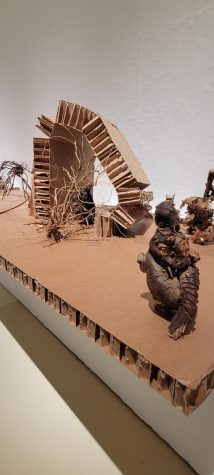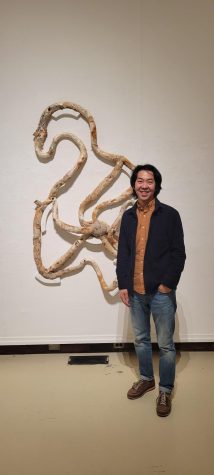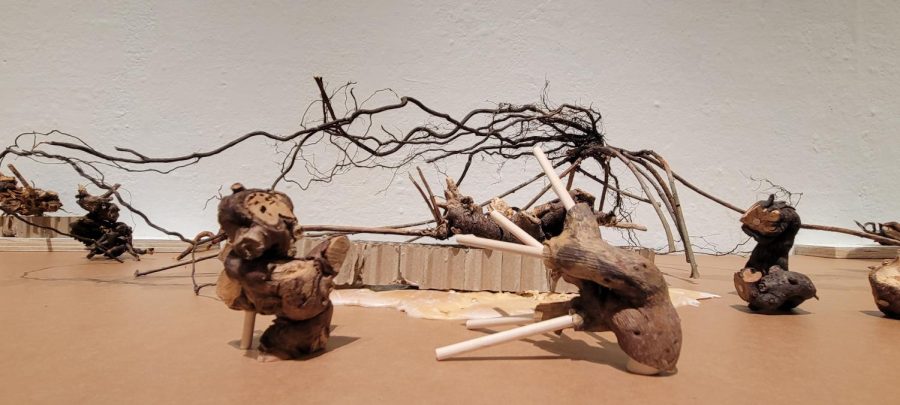Bringing art and communication together with “Roote Wordes”
April 12, 2023
Seattle-based artist and sculpter Rob Rhee sat down with CWU’s writing curriculum coordinator and lecturer Matt Martinson at the front of a packed room in Randall Hall on April 6 to discuss his exhibit in the Sarah Spurgeon Art Gallery, “Roote Wordes.”
Appreciation for the land CWU resides on was expressed, along with a brief history about the land and the people who lived here before colonialism. 
The event was co-sponsored by the department of English because the exhibit ties poetry and sculptural art together. Largely based around natural forms of blackberry roots, “Roote Wordes” explores relationships and communication found in nature.
Rhee explained that he saw gardeners ripping up blackberry roots, and he started picking them up and putting them in his bag, unsure of what they were for but certain he wanted to explore the artistic possibilities they had within them.
Heather Horn Johnson, the Sarah Spurgeon gallery manager, said that Rhee’s recent works have had a natural theme, similar to “Roote Wordes.”
According to Johnson, Rhee made a collection of sculptures by growing gourds inside sculptural frames that he built.
“It was sort of this self-imposed, man-made structure and this natural form took shape around it and through it,” Johnson said.
“Roote Wordes” is another instance of Rhee’s observation of how connected nature is with the human experience.
“He’s using the foods and the natural elements in a way that kind of communicates and intermingles with human communication,” Johnson said.
What she finds most interesting about this exhibit is that it is unique and special because it displays both art and language; there is an epic poem by Rhee that is written with foam on the walls throughout the gallery.
The casual tone set by Rhee and Martinson sitting with their chairs faced towards each other and angled out to the audience allowed for more humorous and serious engagement from the audience.
Emily Jones, a senior studio art major, volunteered to help put the exhibit together and said that the artist talk was unique.

“It was really cool, because rather than just one guy, it was a conversation,” Jones said. “Rob is just super awesome and very good at answering questions and engaging with the audience.”
Jones helped to put the exhibit together by working with the foam.
“I met Rob, and he’s a super awesome dude,” Jones said. “And he was like, ‘this is the poem we’re writing with shaving cream on the wall. Do you think you can do that?’ And I said, ‘yeah, I can do that.’”
According to Rhee, foam models presence, absence, and plurality.
Mandi Griffin, a senior fine arts major, said that she also helped Rhee’s vision come to life.
“[Rhee] decided to change the width of how the writing was put up on the wall,” Griffin said. “So it was just like a spacing issue, it wasn’t going up the way he wanted and so I helped make the template into a little smaller size.”
She said that Rhee was personable and that it was reassuring to hear that learning on the fly is a relatable experience among artists.
Griffin also said that CWU students should take time to observe the little details of the exhibit, such as the cardboard pieces that separate color and words that were originally unplanned.
“I think those little details on how to do it on the fly [are] really essential to making a show because, as much as you can plan, there’s always going to be something that you might have to change after,” Griffin said.
Junior Art and Spanish Major Tyler Raymundo said that the artist talk was interesting to him because of his interest in languages and existential conversation. He said that there was some overlap between his art history classes and Rhee’s talk.
Raymundo commented on how Rhee’s use of space in the gallery was intriguing, how the poem takes up entire walls, and he liked the implication of the materials that were used, such as blackberry roots and cardboard.
“I think just having it be like a really cool combination of Earthy materials that we know [are] going to fade out over time, I think that’s very powerful,” Raymundo said.
Sandra Rivera, a senior studio art major, said, “my favorite part was just learning about the different materials and the process that the artist goes through to make all of this work.”
Johnson said the exhibit has something for those studying English, so art and design students are not the only people who can get something out of it. She emphasized how special featuring Rhee’s artwork is at CWU.
“I don’t know how many students at CWU have had the opportunity to go to a major metropolitan art gallery or museum,” Johnson said. “I don’t know if any have been to the Seattle Art Museum, the Portland Art Museum, any of those big spaces. We’re hoping to be able to bring some of those leading contemporary artists here so that [CWU students] can see it and experience it- and for free.”


